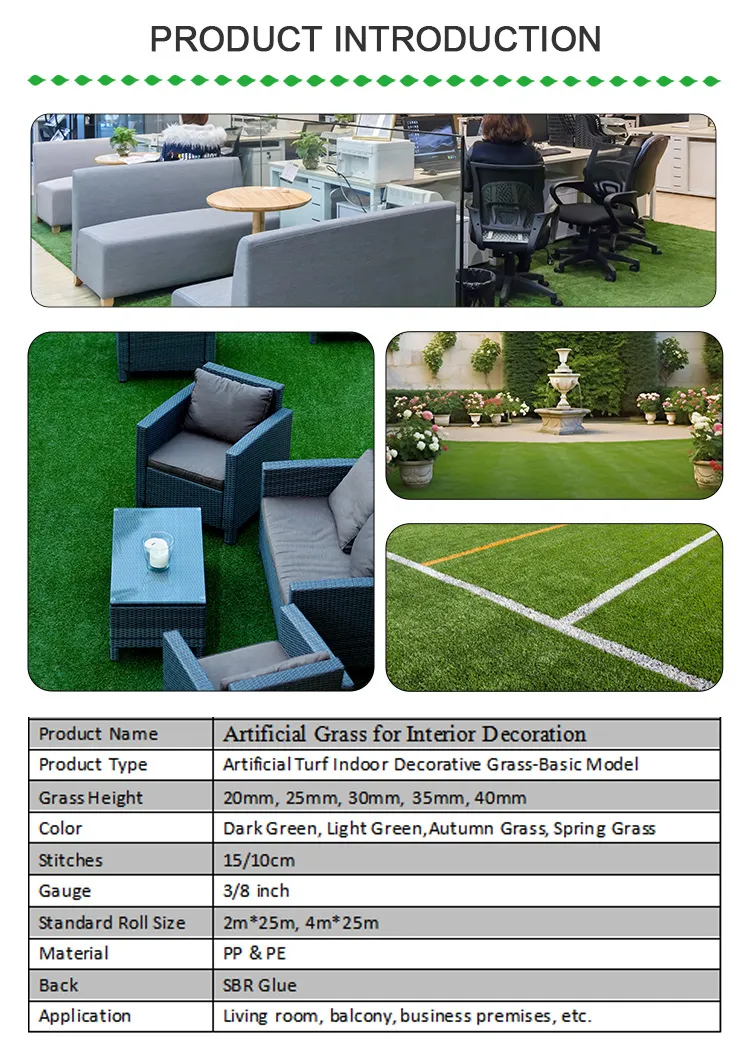
- Afrikaans
- Arabic
- Belarusian
- Bengali
- Czech
- Danish
- Dutch
- English
- Esperanto
- Estonian
- Finnish
- French
- German
- Greek
- Hindi
- Hungarian
- Icelandic
- Indonesian
- irish
- Italian
- Japanese
- kazakh
- Rwandese
- Korean
- Kyrgyz
- Lao
- Latin
- Latvian
- Malay
- Mongolian
- Myanmar
- Norwegian
- Persian
- Polish
- Portuguese
- Romanian
- Russian
- Serbian
- Spanish
- Swedish
- Tagalog
- Tajik
- Thai
- Turkish
- Turkmen
- Ukrainian
- Urdu
- Uighur
- Uzbek
- Vietnamese
Benefits of Artificial Turf Installation Over Concrete Surfaces for Outdoor Spaces
Dec . 04, 2024 09:28 Back to list
The Advantages of Artificial Turf Over Concrete
In recent years, the demand for outdoor recreational spaces has surged, leading to the exploration of innovative materials that enhance both functionality and aesthetics. Among these materials, artificial turf has emerged as a favored alternative to traditional concrete surfaces for various applications, from sports fields to playgrounds and even residential yards. This article aims to explore the significant advantages of artificial turf over concrete, focusing on usability, safety, environmental impact, and overall aesthetics.
Usability and Comfort
One of the most compelling reasons to choose artificial turf over concrete is the sheer comfort it provides. Concrete surfaces can be harsh and unforgiving, making them less suitable for activities that involve physical exertion such as sports, children’s play, or even outdoor yoga. Artificial turf, on the other hand, offers a soft, cushioned surface that reduces the risk of injury from falls and enhances the overall user experience.
Moreover, artificial turf maintains its quality and usability across various weather conditions. Unlike concrete, which can become too hot to walk on during the summer months or slippery when wet, artificial turf offers a stable, slip-resistant surface that is suitable for year-round use. This adaptability makes it ideal for multi-purpose areas, further increasing its utility.
Safety Considerations
Safety is a paramount concern for parents, sports facility managers, and urban planners alike. Concrete can present numerous safety hazards, including the risk of serious injuries from falls and a hard surface that can exacerbate injuries. In contrast, artificial turf provides a safer environment for children and athletes alike. Its shock-absorbing properties help mitigate the impact of falls, thus reducing the likelihood of injuries. Various studies have shown that artificial turf can significantly lower the risk of concussions and other serious injuries, making it a preferred choice for playgrounds and sports fields.
Additionally, artificial turf can be designed with advanced drainage systems that prevent water accumulation, reducing the risk of slips and falls. This safety feature is particularly important in areas prone to heavy rain, where standing water on concrete surfaces can pose a significant hazard.
artificial turf over concrete

Environmental Impact
As society becomes increasingly aware of environmental issues, the choice of materials used in outdoor spaces has come under scrutiny. While concrete has long been the traditional choice due to its durability, it comes with a host of environmental concerns. The production of concrete is energy-intensive and contributes significantly to carbon emissions. Furthermore, concrete surfaces contribute to urban heat islands, making cities hotter and more uncomfortable.
Conversely, many modern artificial turf products are designed with sustainability in mind. They often incorporate recycled materials and are manufactured using processes that minimize environmental impact. Additionally, artificial turf eliminates the need for harmful pesticides, fertilizers, and excessive water consumption associated with maintaining natural grass. This reduction in resource use makes artificial turf a more environmentally friendly option, aligning with the push towards sustainability.
Aesthetic Appeal
Finally, the aesthetic appeal of artificial turf cannot be overlooked. While concrete can appear dull and uninviting, artificial turf provides a lush, green appearance that enhances the aesthetics of any space. It offers a visually pleasing landscape that can transform barren areas into vibrant, inviting environments.
Artificial turf can be customized in terms of color and texture, allowing for creative freedom in designing outdoor spaces. This flexibility makes it an attractive option for anyone looking to create a visually appealing landscape whether it be for sports, community parks, or home gardens.
Conclusion
In summary, the advantages of artificial turf over concrete are plentiful. With its superior comfort, enhanced safety features, reduced environmental footprint, and unmatched aesthetic appeal, artificial turf emerges as a clear winner for a variety of applications. As communities continue to prioritize sustainable, safe, and enjoyable outdoor spaces, the shift towards artificial turf as an alternative to concrete becomes increasingly evident. Utilizing artificial turf not only meets the demands of modern outdoor experiences but also contributes to a healthier and more vibrant environment for all.
-
The Benefits of Artificial Turf for Indoors
NewsJul.15,2025
-
How Artificial Grass Suppliers Ensure Quality Products
NewsJul.15,2025
-
Artificial Grass and Pets: A Space for Relaxation
NewsJul.08,2025
-
Balcony & Outdoor Decoration with Artificial Grass
NewsJul.08,2025
-
Best Indoor Artificial Grass for Home
NewsJul.07,2025
-
Best Pet Turf for Dogs: Safe & Durable Artificial Grass Options
NewsJul.07,2025
Products categories









